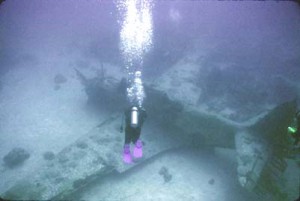InTrans / Apr 23, 2013
Aircraft archaeology: A new frontier
Go! Magazine
 posted on April 23, 2013
posted on April 23, 2013
Recently, I attempted to write a careers post about Aircraft archaeology for Go!. There was just one small problem. It’s a relatively new field; you won’t see it listed on any course curriculum, or on job postings. In fact, most of the people engaged in aircraft archaeology are doing so in their spare time, and they all seem to do it very differently. They are the weekend warriors.

According to Ric Gillespie, and his non-profit organization, The International Group for Historic Aircraft Recovery (TIGHAR), aircraft archaeology is the attempt to recover and conserve historic aircraft from, “the teeth of time.”
Trey Brandt is one of these “weekend warriors.” An avid hiker, Trey has uncovered more than 400 crash sites in Arizona and the Southwest. The crash sites he discovers are the product of failed military flight training. He searches the crashes thoroughly, photographs them, takes notes, and works to discover the history surrounding these sites.
According to Aviation Archaeology Research and Investigation (AAIR), the important aspect of aviation or aircraft archaeology is not necessarily the recovery of the aircraft, but the preservation and documentation of the site itself. AAIR is interested in military sites in the southwest and the people who lost their lives during WWII, especially, people on those recovered flights.
According to their website, “Many of these people have been forgotten and their history lost. The goal of aviation archaeology is to record these incidents in historical context rather than record just why it crashed as can (sometimes) be found in government records.”
Many of the planes discovered by aircraft archaeologists seem to be military planes from WWII or earlier, and a good deal of them seem to be located in the American Southwest. Ric Gillepie and TIGHAR are exploring some of the more exotic historic wreck sites—from Canada, to Wales, to the Phoenix Islands. Wherever you’re looking for aircraft, the important aspect of aircraft archaeology is the idea of preserving the history surrounding the events leading up to and following the crash. Currently, aircraft archaeology is not a lucrative career field. However, there are places you can volunteer your time, if you are interested. Organizations like TIGHAR are run mainly thanks to the efforts of volunteers. TIGHAR also offers training as does AAIR.
The important work being done by these groups is paving the way for a future profession. So if you’re a pioneer at heart, this just might be a field for you.
By Alex Werner, Go! Staff Writer